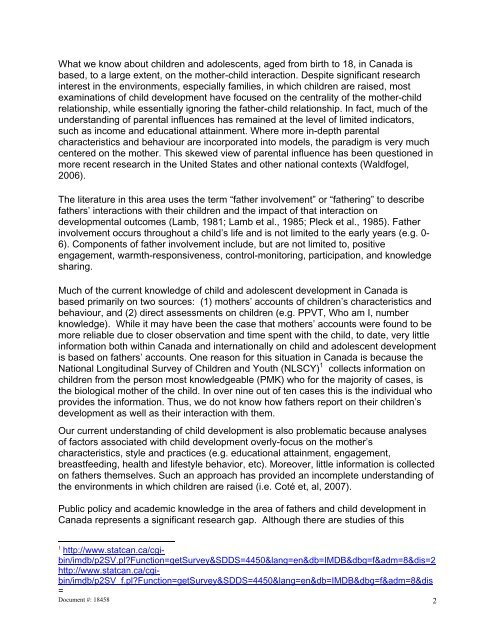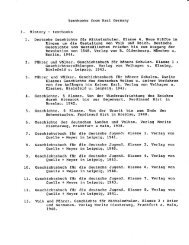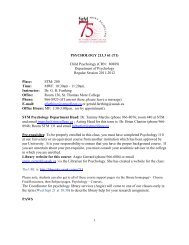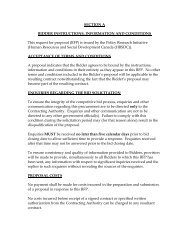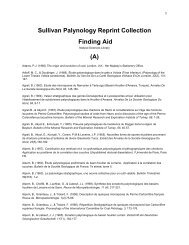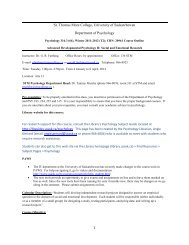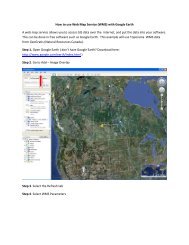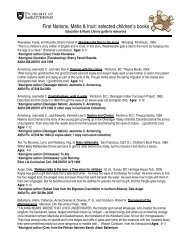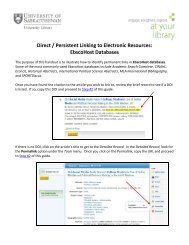Father involvement and child and adolescent ... - University Library
Father involvement and child and adolescent ... - University Library
Father involvement and child and adolescent ... - University Library
Create successful ePaper yourself
Turn your PDF publications into a flip-book with our unique Google optimized e-Paper software.
What we know about <strong>child</strong>ren <strong>and</strong> <strong>adolescent</strong>s, aged from birth to 18, in Canada is<br />
based, to a large extent, on the mother-<strong>child</strong> interaction. Despite significant research<br />
interest in the environments, especially families, in which <strong>child</strong>ren are raised, most<br />
examinations of <strong>child</strong> development have focused on the centrality of the mother-<strong>child</strong><br />
relationship, while essentially ignoring the father-<strong>child</strong> relationship. In fact, much of the<br />
underst<strong>and</strong>ing of parental influences has remained at the level of limited indicators,<br />
such as income <strong>and</strong> educational attainment. Where more in-depth parental<br />
characteristics <strong>and</strong> behaviour are incorporated into models, the paradigm is very much<br />
centered on the mother. This skewed view of parental influence has been questioned in<br />
more recent research in the United States <strong>and</strong> other national contexts (Waldfogel,<br />
2006).<br />
The literature in this area uses the term “father <strong>involvement</strong>” or “fathering” to describe<br />
fathers’ interactions with their <strong>child</strong>ren <strong>and</strong> the impact of that interaction on<br />
developmental outcomes (Lamb, 1981; Lamb et al., 1985; Pleck et al., 1985). <strong>Father</strong><br />
<strong>involvement</strong> occurs throughout a <strong>child</strong>’s life <strong>and</strong> is not limited to the early years (e.g. 0-<br />
6). Components of father <strong>involvement</strong> include, but are not limited to, positive<br />
engagement, warmth-responsiveness, control-monitoring, participation, <strong>and</strong> knowledge<br />
sharing.<br />
Much of the current knowledge of <strong>child</strong> <strong>and</strong> <strong>adolescent</strong> development in Canada is<br />
based primarily on two sources: (1) mothers’ accounts of <strong>child</strong>ren’s characteristics <strong>and</strong><br />
behaviour, <strong>and</strong> (2) direct assessments on <strong>child</strong>ren (e.g. PPVT, Who am I, number<br />
knowledge). While it may have been the case that mothers’ accounts were found to be<br />
more reliable due to closer observation <strong>and</strong> time spent with the <strong>child</strong>, to date, very little<br />
information both within Canada <strong>and</strong> internationally on <strong>child</strong> <strong>and</strong> <strong>adolescent</strong> development<br />
is based on fathers’ accounts. One reason for this situation in Canada is because the<br />
National Longitudinal Survey of Children <strong>and</strong> Youth (NLSCY) 1 collects information on<br />
<strong>child</strong>ren from the person most knowledgeable (PMK) who for the majority of cases, is<br />
the biological mother of the <strong>child</strong>. In over nine out of ten cases this is the individual who<br />
provides the information. Thus, we do not know how fathers report on their <strong>child</strong>ren’s<br />
development as well as their interaction with them.<br />
Our current underst<strong>and</strong>ing of <strong>child</strong> development is also problematic because analyses<br />
of factors associated with <strong>child</strong> development overly-focus on the mother’s<br />
characteristics, style <strong>and</strong> practices (e.g. educational attainment, engagement,<br />
breastfeeding, health <strong>and</strong> lifestyle behavior, etc). Moreover, little information is collected<br />
on fathers themselves. Such an approach has provided an incomplete underst<strong>and</strong>ing of<br />
the environments in which <strong>child</strong>ren are raised (i.e. Coté et, al, 2007).<br />
Public policy <strong>and</strong> academic knowledge in the area of fathers <strong>and</strong> <strong>child</strong> development in<br />
Canada represents a significant research gap. Although there are studies of this<br />
1<br />
http://www.statcan.ca/cgibin/imdb/p2SV.pl?Function=getSurvey&SDDS=4450&lang=en&db=IMDB&dbg=f&adm=8&dis=2http://www.statcan.ca/cgibin/imdb/p2SV_f.pl?Function=getSurvey&SDDS=4450&lang=en&db=IMDB&dbg=f&adm=8&dis<br />
=<br />
Document #: 18458<br />
2


